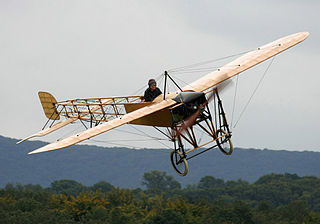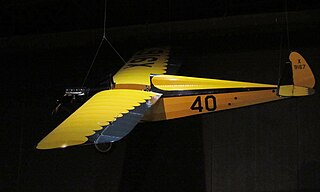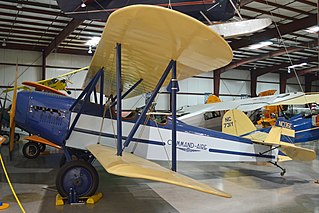
The Avro 504 was a First World War biplane aircraft made by the Avro aircraft company and under licence by others. Production during the war totalled 8,970 and continued for almost 20 years, making it the most-produced aircraft of any kind that served in any military capacity during the First World War. More than 10,000 were built from 1913 until production ended in 1932.

The Ace Baby Ace, a single-seat, single-engine, parasol wing, fixed-gear light airplane, was marketed as a homebuilt aircraft when its plans were first offered for sale in 1929 — one of the first homebuilt aircraft plans available in the United States. Plans are still available and Baby Aces are still being built. Orland Corben designed a series of aircraft for the Ace Aircraft Manufacturing Company, the Baby Ace, Junior Ace, and Super Ace. Corben's name was associated with the aircraft, and it is commonly known as the Corben Baby Ace.

The Blériot XI is a French aircraft from the pioneer era of aviation. The first example was used by Louis Blériot to make the first flight across the English Channel in a heavier-than-air aircraft, on 25 July 1909. This is one of the most famous accomplishments of the pioneer era of aviation, and not only won Blériot a lasting place in history but also assured the future of his aircraft manufacturing business. The event caused a major reappraisal of the importance of aviation; the English newspaper The Daily Express led its story of the flight with the headline "Britain is no longer an Island".

The Dewoitine D.1 was a French single-seat fighter aircraft of the 1920s, built by the French industrial company Dewoitine.

The Meyers OTW was a 1930s United States training biplane designed by Allen Meyers and built by his Meyers Aircraft Company from 1936 to 1944.

The Spartan C3 is an American three-seat open-cockpit utility biplane from the late 1920s.
The Fisher FP-505 Skeeter is a Canadian single-seat, conventional landing gear, single-engined parasol-wing monoplane kit aircraft designed for construction by amateur builders. Fisher Flying Products was originally based in Edgeley, North Dakota, USA but the company is now located in Woodbridge, Ontario, Canada.
The Pop's Props Cloudster is a single seat, open-cockpit, parasol wing, single-engine monoplane, that was first flown in 1995. The aircraft was produced by Pop's Props of Cooksville, Illinois and made available as plans or in kit form. The company is no longer in business and kit production has been transferred to Simplex Aeroplanes of Old Saybrook, Connecticut.
The Pop's Props Zing is a single seat, open-cockpit, parasol wing, single-engine monoplane, first flown in 1996. The aircraft was designed by Scott Land and produced by Pop's Props of Cooksville, Illinois in the form of plans and an aircraft kit. The company is no longer in business and the aircraft kit is now available from Simplex Aeroplanes of Old Saybrook, Connecticut.

The Curtiss Oriole was an American three-seat general-purpose biplane.

The Church Midwing JC-1, a.k.a. Church Mid-Wing Sport, is a midwing racing aircraft designed by James Church using the fuselage of a Heath aircraft.

The Dormoy Bathtub was a simple-to-construct, high wing racing aircraft of the 1920s.

The Morane-Saulnier MS.180 is a single engine, single parasol wing aerobatic trainer designed in France in 1929. About seventeen were produced and used in French flying clubs, some surviving World War II and one remaining in use at a club until the 1970s. Before World War II, some were used by Spanish Republican forces to train pilots in the Spanish Civil War. Two MS.181s are still flying.

The Aerotique Parasol is an American parasol-wing, strut-braced, conventional landing gear, single-seat, open cockpit, single engine in tractor configuration, ultralight aircraft that was designed as an ultralight version of the 1926 vintage Heath Parasol. It was originally produced by Yesteryear Aviation and later by Aerotique Aviation. The aircraft was supplied as factory-built only.
The Ganagobie is a single place, parasol wing homebuilt aircraft that was built by Willam and James Lobet, first flying in 1953.
The Celier XeWing is a Polish ultralight aircraft that was designed by Frenchman Raphael Celier and produced by his company Celier Aviation of Jaktorów-Kolonia, Poland. It was introduced at AERO Friedrichshafen in 2009. The aircraft was intended to be supplied as a kit for amateur construction or as a complete ready-to-fly-aircraft.
The Weller UW-9 Sprint is a German ultralight aircraft designed and produced by Weller Flugzeugbau of Bibersfeld. The aircraft is supplied as a kit for amateur construction or as a complete ready-to-fly-aircraft.
The Long Anzani Longster AL-1 is an early homebuilt aircraft.
The Dietrich-Gobiet DP.VII was a simple, low power, German sports aircraft flown in early 1924.

The Command-Aire 3C3 and similar 4C3 and 5C3 are American three-seat open cockpit utility, training and touring biplanes developed by Command-Aire in the late 1920s and early 1930s.

















